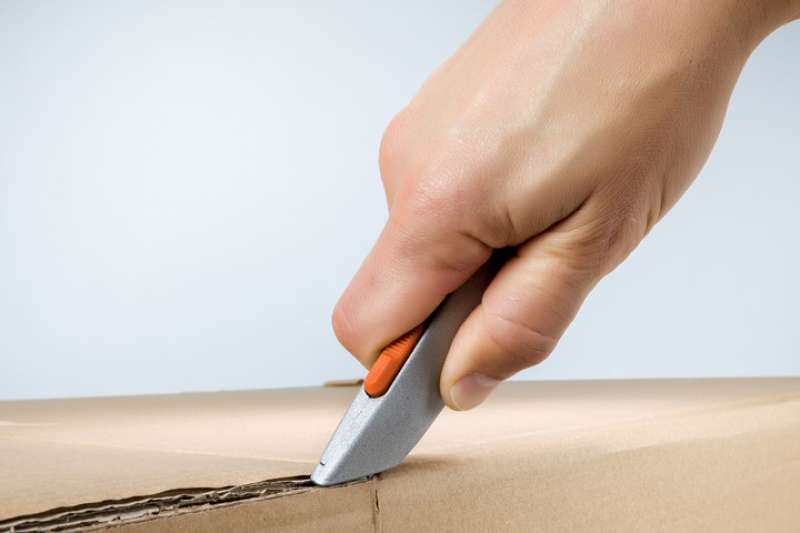

utility knife cutting box
In the United States, injuries from lacerations, cuts, and punctures made up 13.3 percent of all industrial incidents in 2019. Approximately 15,380 cases were reported, according to the Bureau of Labor Statistics.
Choosing the right utility knives can help lower the number of reported cases of lacerations, cuts, and punctures in the workplace. It also reduces the amount of lost work time for the employees and money for both the employee and company.
Considerations
As a safety manager, you must consider your needs before purchasing the right utility knife.
Ask yourself: How often does your team need to cut something? Industrial workers need to cut things frequently. Some workers may need utility knives all day, while others only require them occasionally. Knowing the frequency helps you purchase accordingly.
Consider, too, what employees are cutting. Cardboard products need something more durable than jobs that usually only cut through tape. Construction workers need something tough that can handle cutting linoleum, roofing shingles, or even rope.
Safety
Safety is one of the most significant considerations for choosing the right utility knife. The correct knife for the job will help keep workers safe from injury.
Retractable utility knives pull the blade back into the housing to protect workers. Not all of them automatically retract, though. Some, with manual retraction, have a button that must be pushed to extend and retract the blade. These tools are safe only as long as the user remembers to retract the blade when finished.
With auto-retractable blades, workers engage the button to extend the blade. If the button is released, it will retract into the housing. This type of knife is ideal for anyone cutting lengths.
No matter what design management chooses, all employees should have training in the appropriate safety measures for their job. Lessons should include cutting away from the body and making sure cutting happens in a distraction-free environment.
Blades
When choosing the right knife, remember that not all blades are equal.
Non-heat treated blades are, as the name implies, not treated by heat. While these are a more inexpensive blade option, they are not as strong or durable as heat-hardened blades. As these blades have the possibility of breaking, they should only be used with caution.
The induction-hardened blade is heat-treated. These blades are more durable than non-heated blades and are stiffer.
Some managers opt for a bi-metal blade that has two different pieces of metal bonded together. These blades tend to be stronger than non-heated blades.
Ceramic blades have unique properties that can make them safer. These blades are non-magnetic, non-conductive, non-sparking, and chemically inert—meaning they never rust. They are also safe up to 1600 degrees Celsius. Look for innovations in edge grinding technology as well, to find blades that help reduce the chance of laceration injuries and that keep their edge longer than metal, which dulls much quicker than ceramic.
Carbide blades are a mix of steel and ceramic. The steel base of the blade is coated with ceramic powder to get some of the benefits of both material.
Uses
Not all utility knives are made equal. Some are designed to take on heavy-duty jobs such as cutting through drywall. It pays to know what the job entails when choosing the appropriate knife. The user does not want to pick a blade that will quickly become blunt before the project is complete.
In addition to choosing a blade designed to handle the work, ensure materials are appropriate for each task. Blades that come into contact with food have different requirements than blades used for cutting tape. By industry standard, utility knives used around food need to be metal detectable.
Choosing the right utility knife blade is only half the struggle. Choosing a utility knife with the appropriate handle is the other half. Like the blade, the proper handle depends on the job. For those who use repetitive cutting motions, a utility knife with an ergonomic handle is the best design, as it provides greater protection against strain injuries.
Choosing the right utility knife is a combination of understanding workplace needs and blade uses. Personal preference for the worker should be considered as they will be the ones using the utility knife during the shift. However, their options should be limited to utility knives that follow safety guidelines and use task-appropriate blades. Brittle blades should not be near food items, and metal blades should not be used for electrical systems.
I'm so excited to tackle all my home improvement projects! From plumbing to DIY and cleaning - I'm ready to get down to work! #homerepair #homecleaning #plumbing #diy #fixerupper #realestate #renovation #interiordesign #farmhouse #diy #homedecor #hgtv #home #farmhousedecor #modernfarmhouse #farmhousestyle #fixerupperstyle #fixandflip #homerenovation #realestateinvesting #beforeandafter #homesweethome #remodel #realestateinvestor #interior #realtor #joannagaines #flippinghouses #countryliving #design #homedesign #farmhouseinspired #investmentproperty #bhghome #renovationproject #farmhousekitchen #homeimprovement #farmhouseliving #cottagestyle #decor #realestateagent #magnoliahome #homeinspo #magnoliamarket #kitchendesign #dreamhome #shiplap #construction #houseflipping #investor #farmhousedesign #architecture #farmhousechic #homereno #rusticdecor #reno #kitchenremodel #webuyhouses #magnoliatable #rentalproperty #fixerupperinspired #newhome #interiors #homeremodel

